Legal Analysis: Australian Safeway Stores v Zaluzna Case Study (2017)
VerifiedAdded on 2020/02/24
|11
|2775
|2244
Case Study
AI Summary
This case study examines the landmark case of Australian Safeway Stores v Zaluzna (1987), which addresses the tort of negligence, specifically the duty of care owed by occupiers to invitees. The case involves a customer, Zaluzna, who slipped and was injured in a Safeway supermarket due to a wet floor. The analysis covers the background of the case, the issues raised by the plaintiff and the defendant, their respective arguments, and the court's decision. The court determined that the trial judge erred in not considering the application of Donoghue v Stevenson and established that the occupier's duty of care is no more or no less than the general duty of reasonable care. The case highlights the importance of foreseeability and proximity in establishing a duty of care, emphasizing that the occupier has a responsibility to provide a safe environment for customers. The critical analysis supports the court's decision, emphasizing the presence of both proximity and foreseeability, thus upholding the defendant's liability for negligence. The case study concludes with a discussion of the implications of the court's decision on business law, with reference to the principles of negligence and duty of care.
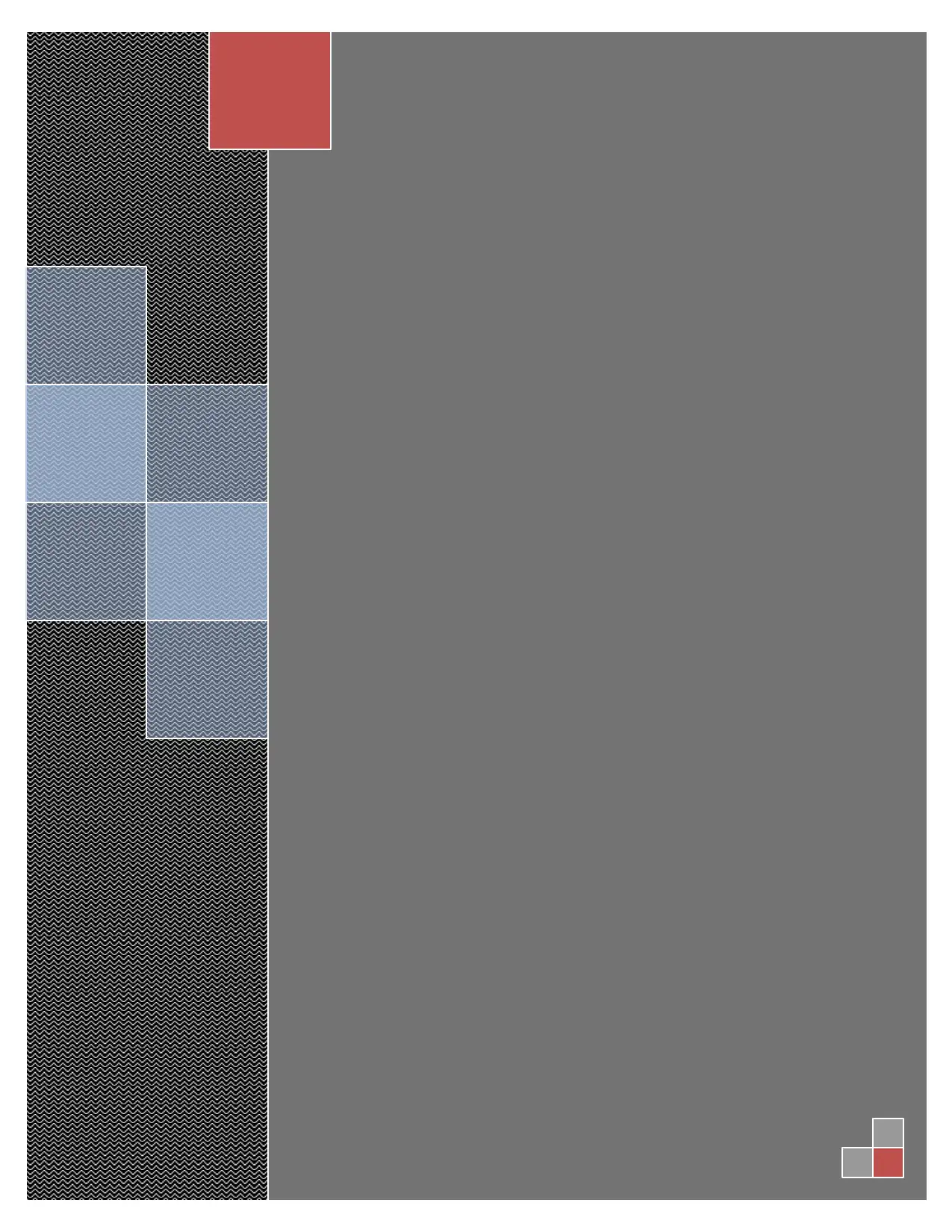
Paraphrase This Document
Need a fresh take? Get an instant paraphrase of this document with our AI Paraphraser

AUSTRALIAN SAFEWAY STORES V ZALUZNA (1987)
2
Contents
Introduction......................................................................................................................................3
Background......................................................................................................................................3
Issues................................................................................................................................................4
Arguments........................................................................................................................................5
Court Decision.................................................................................................................................6
Critical Analysis..............................................................................................................................8
References......................................................................................................................................10
2
Contents
Introduction......................................................................................................................................3
Background......................................................................................................................................3
Issues................................................................................................................................................4
Arguments........................................................................................................................................5
Court Decision.................................................................................................................................6
Critical Analysis..............................................................................................................................8
References......................................................................................................................................10
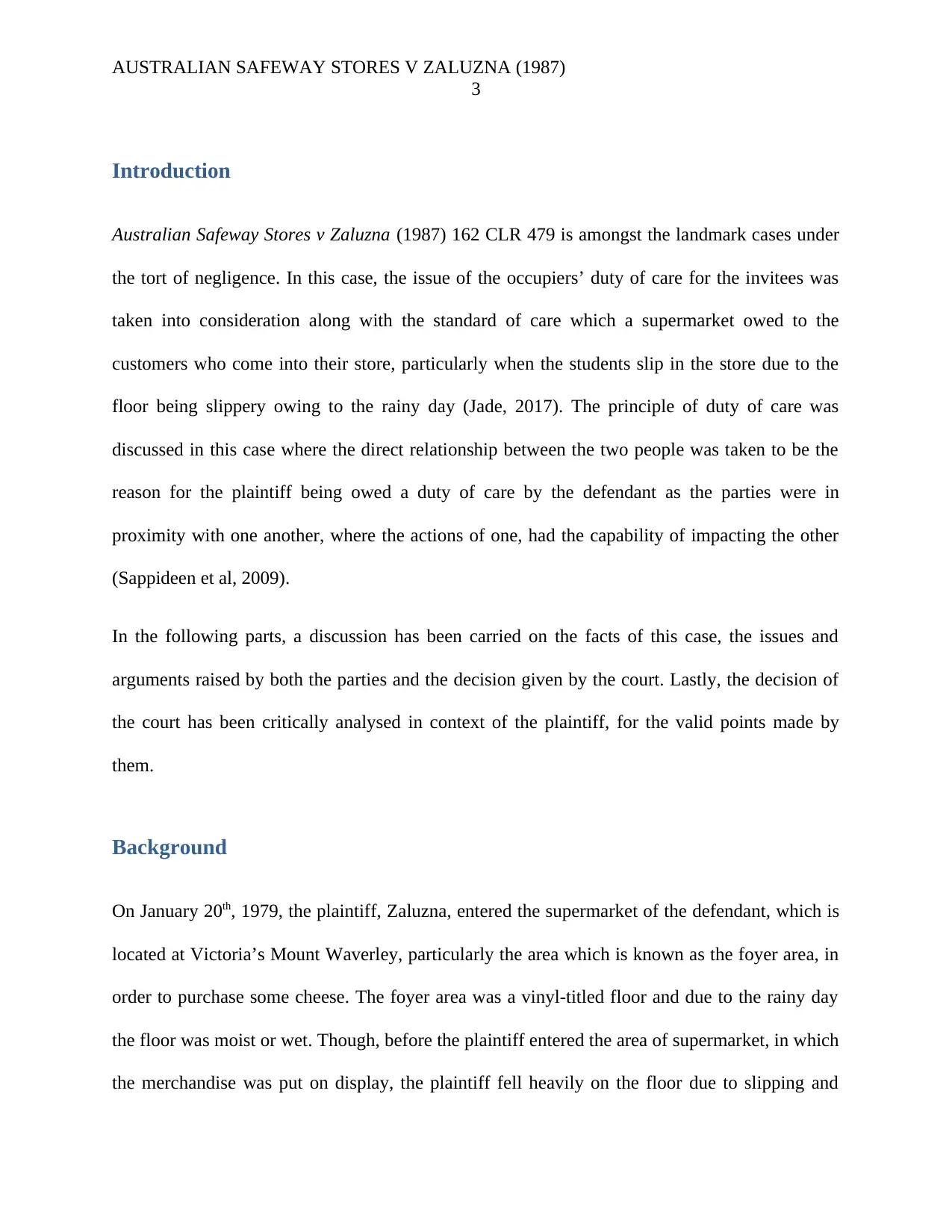
AUSTRALIAN SAFEWAY STORES V ZALUZNA (1987)
3
Introduction
Australian Safeway Stores v Zaluzna (1987) 162 CLR 479 is amongst the landmark cases under
the tort of negligence. In this case, the issue of the occupiers’ duty of care for the invitees was
taken into consideration along with the standard of care which a supermarket owed to the
customers who come into their store, particularly when the students slip in the store due to the
floor being slippery owing to the rainy day (Jade, 2017). The principle of duty of care was
discussed in this case where the direct relationship between the two people was taken to be the
reason for the plaintiff being owed a duty of care by the defendant as the parties were in
proximity with one another, where the actions of one, had the capability of impacting the other
(Sappideen et al, 2009).
In the following parts, a discussion has been carried on the facts of this case, the issues and
arguments raised by both the parties and the decision given by the court. Lastly, the decision of
the court has been critically analysed in context of the plaintiff, for the valid points made by
them.
Background
On January 20th, 1979, the plaintiff, Zaluzna, entered the supermarket of the defendant, which is
located at Victoria’s Mount Waverley, particularly the area which is known as the foyer area, in
order to purchase some cheese. The foyer area was a vinyl-titled floor and due to the rainy day
the floor was moist or wet. Though, before the plaintiff entered the area of supermarket, in which
the merchandise was put on display, the plaintiff fell heavily on the floor due to slipping and
3
Introduction
Australian Safeway Stores v Zaluzna (1987) 162 CLR 479 is amongst the landmark cases under
the tort of negligence. In this case, the issue of the occupiers’ duty of care for the invitees was
taken into consideration along with the standard of care which a supermarket owed to the
customers who come into their store, particularly when the students slip in the store due to the
floor being slippery owing to the rainy day (Jade, 2017). The principle of duty of care was
discussed in this case where the direct relationship between the two people was taken to be the
reason for the plaintiff being owed a duty of care by the defendant as the parties were in
proximity with one another, where the actions of one, had the capability of impacting the other
(Sappideen et al, 2009).
In the following parts, a discussion has been carried on the facts of this case, the issues and
arguments raised by both the parties and the decision given by the court. Lastly, the decision of
the court has been critically analysed in context of the plaintiff, for the valid points made by
them.
Background
On January 20th, 1979, the plaintiff, Zaluzna, entered the supermarket of the defendant, which is
located at Victoria’s Mount Waverley, particularly the area which is known as the foyer area, in
order to purchase some cheese. The foyer area was a vinyl-titled floor and due to the rainy day
the floor was moist or wet. Though, before the plaintiff entered the area of supermarket, in which
the merchandise was put on display, the plaintiff fell heavily on the floor due to slipping and
⊘ This is a preview!⊘
Do you want full access?
Subscribe today to unlock all pages.

Trusted by 1+ million students worldwide

AUSTRALIAN SAFEWAY STORES V ZALUZNA (1987)
4
sustained physical injuries. As a result of this, the plaintiff initiated claims for negligence of the
defendant in the Supreme Court of Victoria and applied for damages, stating that both a general
duty of care and the duty which is owned by the occupier to an invitee were breached
(Australasian Legal Information Institute, 2017a).
The issue had been taken to the trial court, where it was recognized that the moisture on the floor
did not constitute as a hazard for the customers and was nothing new as the customers shopping
on wet morning would normally expect the same to happen. As this was not found to be an
unusual danger, the actions of the plaintiff failed in the trail court. The trial judge stated that this
case was not such where it would be deemed as right to look out for duty of care on the basis of
Donoghue v Stevenson [1932] AC 562. And the verdict was made relying only on the case of
London Graving Dock Co. Ltd. v. Horton (1951) AC 737 and the classic exposition of the duty
of the invitor to the invitee as stated under Indermaur v Dames (1866) LR 1 CP 274, based on
which he stated that the defendant had taken the mopping up procedure which was reasonable for
dealing with the possibility of harm (Australasian Legal Information Institute, 2017b).
Issues
The plaintiff raised the issue that the defendant had not only breached its general duty of care,
which they owed to the plaintiff, but also the duty which is owed by the occupier to an invitee.
The plaintiff claimed that the risk of harm was clearly foreseeable in this case, which required
the defendant to take the requisite steps to safeguard the plaintiff against such risk of harm. On
the other hand, the defendant raised the issue that in this case, a general duty of care was not
owed by the defendant to the plaintiff. And that the occupiers’ liability was not applicable in this
case and so, a case of negligence was not present (Jade, 2017).
4
sustained physical injuries. As a result of this, the plaintiff initiated claims for negligence of the
defendant in the Supreme Court of Victoria and applied for damages, stating that both a general
duty of care and the duty which is owned by the occupier to an invitee were breached
(Australasian Legal Information Institute, 2017a).
The issue had been taken to the trial court, where it was recognized that the moisture on the floor
did not constitute as a hazard for the customers and was nothing new as the customers shopping
on wet morning would normally expect the same to happen. As this was not found to be an
unusual danger, the actions of the plaintiff failed in the trail court. The trial judge stated that this
case was not such where it would be deemed as right to look out for duty of care on the basis of
Donoghue v Stevenson [1932] AC 562. And the verdict was made relying only on the case of
London Graving Dock Co. Ltd. v. Horton (1951) AC 737 and the classic exposition of the duty
of the invitor to the invitee as stated under Indermaur v Dames (1866) LR 1 CP 274, based on
which he stated that the defendant had taken the mopping up procedure which was reasonable for
dealing with the possibility of harm (Australasian Legal Information Institute, 2017b).
Issues
The plaintiff raised the issue that the defendant had not only breached its general duty of care,
which they owed to the plaintiff, but also the duty which is owed by the occupier to an invitee.
The plaintiff claimed that the risk of harm was clearly foreseeable in this case, which required
the defendant to take the requisite steps to safeguard the plaintiff against such risk of harm. On
the other hand, the defendant raised the issue that in this case, a general duty of care was not
owed by the defendant to the plaintiff. And that the occupiers’ liability was not applicable in this
case and so, a case of negligence was not present (Jade, 2017).
Paraphrase This Document
Need a fresh take? Get an instant paraphrase of this document with our AI Paraphraser

AUSTRALIAN SAFEWAY STORES V ZALUZNA (1987)
5
Arguments
Each of the parties, in order to prove themselves right, made a lot of arguments before the court.
The plaintiff highlighted that the trial judge had been wrong on the basis of law on stating that a
general duty of care was not owed by the defendant. This was because the trial judge did not take
into consideration the circumstances, which could justify the case of Donoghue v Stevenson
being applied to the present case and that by failing to consider this, a reversible error was
committed. The plaintiff stated that he activity of the defendant was the activity where a
commercial operation was conducted on the premises, which provided for the context of the
accident and which was more dynamic in comparison to the constant movements of the shoppers
who were soaked in rain, over the floor on that particular day (Jade, 2017).
On the other hand, the defendant stated that the condition of floor was due to the wet weather
and this was an unrelated activity to the ones conducted by the defendant and so, a special duty
was not owed. When a new trial was started, the defendant raised three key points. The first one
was related to the relevant relationship pertaining to the proximity regarding that of the occupier
and that of the invitee (Legal Helpdesk Lawyers, 2015). The defendant highlighted that the only
duty of care which was owed by the defendant was the one described under the case of
Indermaur v Dames. The second point raised by the defendant was that the circumstances were
indeed considered by the trail judge on the basis of which, the general duty of care was found to
be present. And the last point raised by the defendant was that in case only a general duty of care
was owed by them, there is no difference in the circumstances which could constitute a general
duty of care and a special duty, which would mean that findings of his Honour meant that a
general common law duty of care was not breached by the defendant (Jade, 2017).
5
Arguments
Each of the parties, in order to prove themselves right, made a lot of arguments before the court.
The plaintiff highlighted that the trial judge had been wrong on the basis of law on stating that a
general duty of care was not owed by the defendant. This was because the trial judge did not take
into consideration the circumstances, which could justify the case of Donoghue v Stevenson
being applied to the present case and that by failing to consider this, a reversible error was
committed. The plaintiff stated that he activity of the defendant was the activity where a
commercial operation was conducted on the premises, which provided for the context of the
accident and which was more dynamic in comparison to the constant movements of the shoppers
who were soaked in rain, over the floor on that particular day (Jade, 2017).
On the other hand, the defendant stated that the condition of floor was due to the wet weather
and this was an unrelated activity to the ones conducted by the defendant and so, a special duty
was not owed. When a new trial was started, the defendant raised three key points. The first one
was related to the relevant relationship pertaining to the proximity regarding that of the occupier
and that of the invitee (Legal Helpdesk Lawyers, 2015). The defendant highlighted that the only
duty of care which was owed by the defendant was the one described under the case of
Indermaur v Dames. The second point raised by the defendant was that the circumstances were
indeed considered by the trail judge on the basis of which, the general duty of care was found to
be present. And the last point raised by the defendant was that in case only a general duty of care
was owed by them, there is no difference in the circumstances which could constitute a general
duty of care and a special duty, which would mean that findings of his Honour meant that a
general common law duty of care was not breached by the defendant (Jade, 2017).
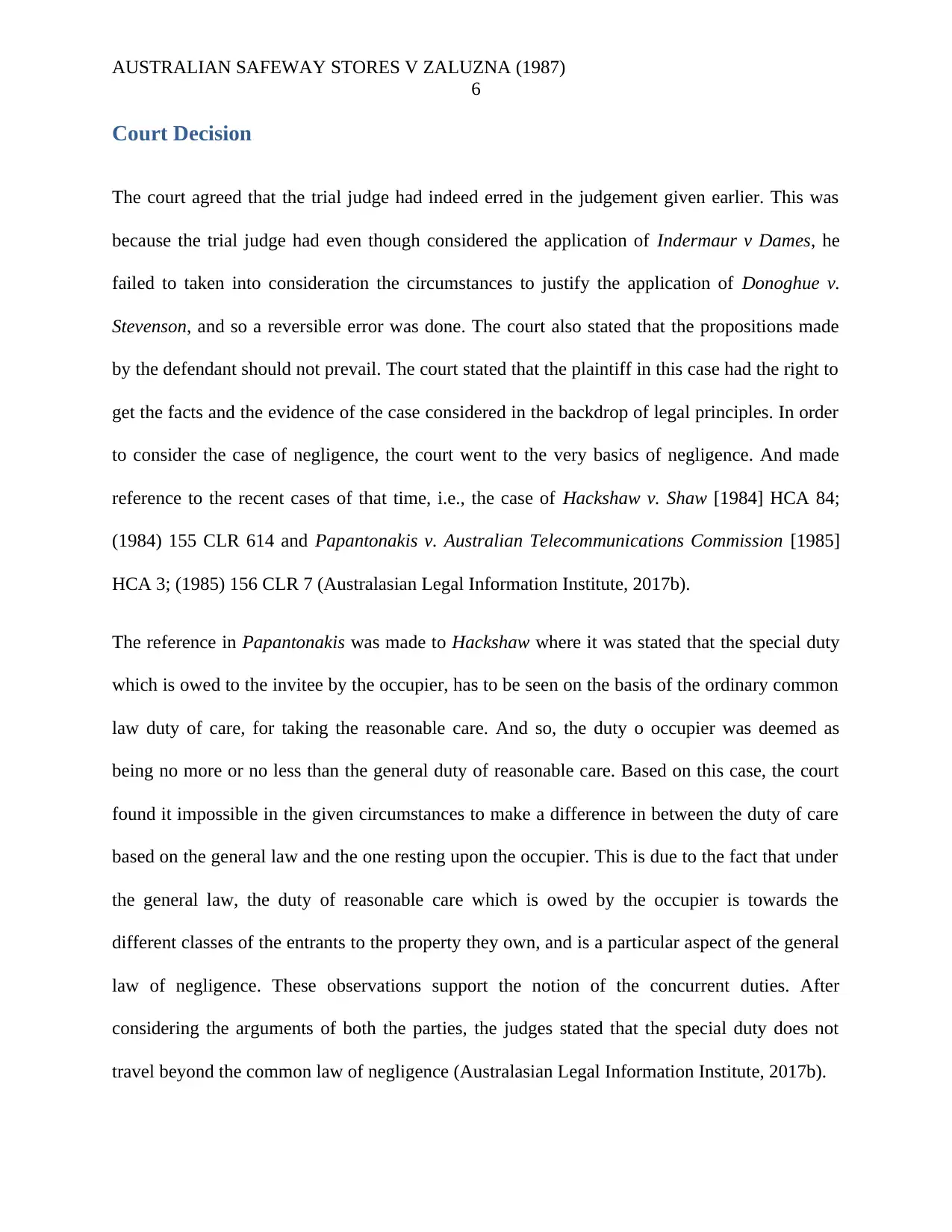
AUSTRALIAN SAFEWAY STORES V ZALUZNA (1987)
6
Court Decision
The court agreed that the trial judge had indeed erred in the judgement given earlier. This was
because the trial judge had even though considered the application of Indermaur v Dames, he
failed to taken into consideration the circumstances to justify the application of Donoghue v.
Stevenson, and so a reversible error was done. The court also stated that the propositions made
by the defendant should not prevail. The court stated that the plaintiff in this case had the right to
get the facts and the evidence of the case considered in the backdrop of legal principles. In order
to consider the case of negligence, the court went to the very basics of negligence. And made
reference to the recent cases of that time, i.e., the case of Hackshaw v. Shaw [1984] HCA 84;
(1984) 155 CLR 614 and Papantonakis v. Australian Telecommunications Commission [1985]
HCA 3; (1985) 156 CLR 7 (Australasian Legal Information Institute, 2017b).
The reference in Papantonakis was made to Hackshaw where it was stated that the special duty
which is owed to the invitee by the occupier, has to be seen on the basis of the ordinary common
law duty of care, for taking the reasonable care. And so, the duty o occupier was deemed as
being no more or no less than the general duty of reasonable care. Based on this case, the court
found it impossible in the given circumstances to make a difference in between the duty of care
based on the general law and the one resting upon the occupier. This is due to the fact that under
the general law, the duty of reasonable care which is owed by the occupier is towards the
different classes of the entrants to the property they own, and is a particular aspect of the general
law of negligence. These observations support the notion of the concurrent duties. After
considering the arguments of both the parties, the judges stated that the special duty does not
travel beyond the common law of negligence (Australasian Legal Information Institute, 2017b).
6
Court Decision
The court agreed that the trial judge had indeed erred in the judgement given earlier. This was
because the trial judge had even though considered the application of Indermaur v Dames, he
failed to taken into consideration the circumstances to justify the application of Donoghue v.
Stevenson, and so a reversible error was done. The court also stated that the propositions made
by the defendant should not prevail. The court stated that the plaintiff in this case had the right to
get the facts and the evidence of the case considered in the backdrop of legal principles. In order
to consider the case of negligence, the court went to the very basics of negligence. And made
reference to the recent cases of that time, i.e., the case of Hackshaw v. Shaw [1984] HCA 84;
(1984) 155 CLR 614 and Papantonakis v. Australian Telecommunications Commission [1985]
HCA 3; (1985) 156 CLR 7 (Australasian Legal Information Institute, 2017b).
The reference in Papantonakis was made to Hackshaw where it was stated that the special duty
which is owed to the invitee by the occupier, has to be seen on the basis of the ordinary common
law duty of care, for taking the reasonable care. And so, the duty o occupier was deemed as
being no more or no less than the general duty of reasonable care. Based on this case, the court
found it impossible in the given circumstances to make a difference in between the duty of care
based on the general law and the one resting upon the occupier. This is due to the fact that under
the general law, the duty of reasonable care which is owed by the occupier is towards the
different classes of the entrants to the property they own, and is a particular aspect of the general
law of negligence. These observations support the notion of the concurrent duties. After
considering the arguments of both the parties, the judges stated that the special duty does not
travel beyond the common law of negligence (Australasian Legal Information Institute, 2017b).
⊘ This is a preview!⊘
Do you want full access?
Subscribe today to unlock all pages.

Trusted by 1+ million students worldwide
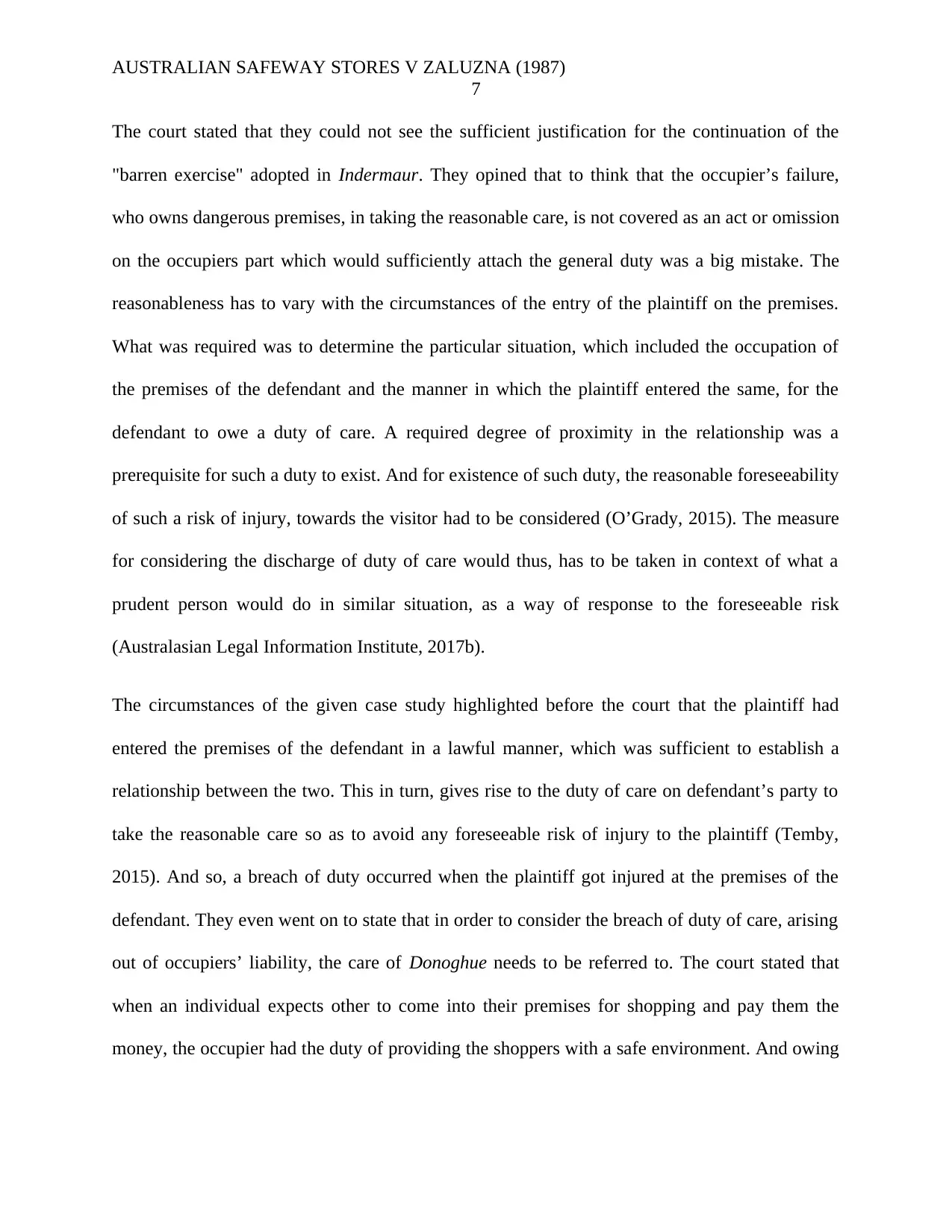
AUSTRALIAN SAFEWAY STORES V ZALUZNA (1987)
7
The court stated that they could not see the sufficient justification for the continuation of the
"barren exercise" adopted in Indermaur. They opined that to think that the occupier’s failure,
who owns dangerous premises, in taking the reasonable care, is not covered as an act or omission
on the occupiers part which would sufficiently attach the general duty was a big mistake. The
reasonableness has to vary with the circumstances of the entry of the plaintiff on the premises.
What was required was to determine the particular situation, which included the occupation of
the premises of the defendant and the manner in which the plaintiff entered the same, for the
defendant to owe a duty of care. A required degree of proximity in the relationship was a
prerequisite for such a duty to exist. And for existence of such duty, the reasonable foreseeability
of such a risk of injury, towards the visitor had to be considered (O’Grady, 2015). The measure
for considering the discharge of duty of care would thus, has to be taken in context of what a
prudent person would do in similar situation, as a way of response to the foreseeable risk
(Australasian Legal Information Institute, 2017b).
The circumstances of the given case study highlighted before the court that the plaintiff had
entered the premises of the defendant in a lawful manner, which was sufficient to establish a
relationship between the two. This in turn, gives rise to the duty of care on defendant’s party to
take the reasonable care so as to avoid any foreseeable risk of injury to the plaintiff (Temby,
2015). And so, a breach of duty occurred when the plaintiff got injured at the premises of the
defendant. They even went on to state that in order to consider the breach of duty of care, arising
out of occupiers’ liability, the care of Donoghue needs to be referred to. The court stated that
when an individual expects other to come into their premises for shopping and pay them the
money, the occupier had the duty of providing the shoppers with a safe environment. And owing
7
The court stated that they could not see the sufficient justification for the continuation of the
"barren exercise" adopted in Indermaur. They opined that to think that the occupier’s failure,
who owns dangerous premises, in taking the reasonable care, is not covered as an act or omission
on the occupiers part which would sufficiently attach the general duty was a big mistake. The
reasonableness has to vary with the circumstances of the entry of the plaintiff on the premises.
What was required was to determine the particular situation, which included the occupation of
the premises of the defendant and the manner in which the plaintiff entered the same, for the
defendant to owe a duty of care. A required degree of proximity in the relationship was a
prerequisite for such a duty to exist. And for existence of such duty, the reasonable foreseeability
of such a risk of injury, towards the visitor had to be considered (O’Grady, 2015). The measure
for considering the discharge of duty of care would thus, has to be taken in context of what a
prudent person would do in similar situation, as a way of response to the foreseeable risk
(Australasian Legal Information Institute, 2017b).
The circumstances of the given case study highlighted before the court that the plaintiff had
entered the premises of the defendant in a lawful manner, which was sufficient to establish a
relationship between the two. This in turn, gives rise to the duty of care on defendant’s party to
take the reasonable care so as to avoid any foreseeable risk of injury to the plaintiff (Temby,
2015). And so, a breach of duty occurred when the plaintiff got injured at the premises of the
defendant. They even went on to state that in order to consider the breach of duty of care, arising
out of occupiers’ liability, the care of Donoghue needs to be referred to. The court stated that
when an individual expects other to come into their premises for shopping and pay them the
money, the occupier had the duty of providing the shoppers with a safe environment. And owing
Paraphrase This Document
Need a fresh take? Get an instant paraphrase of this document with our AI Paraphraser
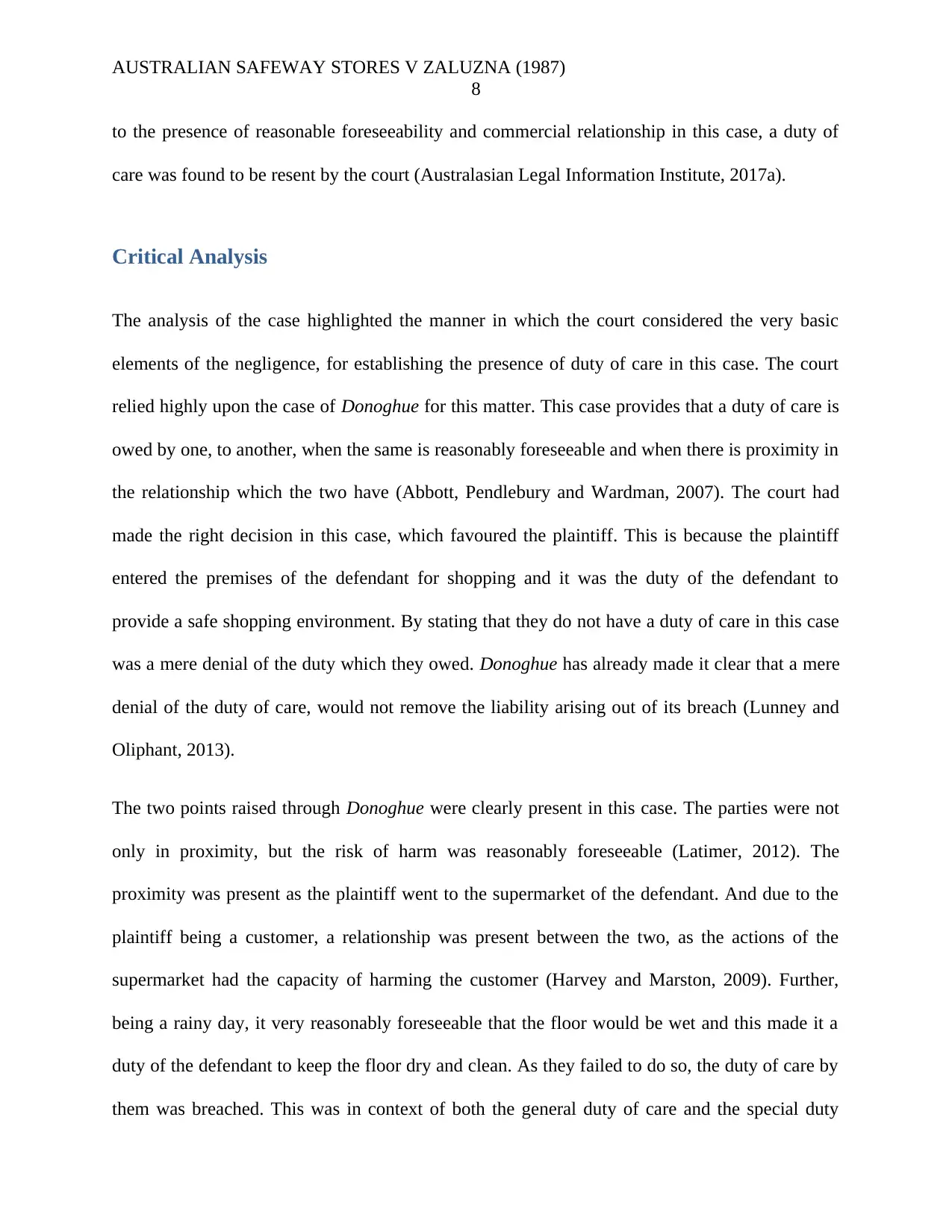
AUSTRALIAN SAFEWAY STORES V ZALUZNA (1987)
8
to the presence of reasonable foreseeability and commercial relationship in this case, a duty of
care was found to be resent by the court (Australasian Legal Information Institute, 2017a).
Critical Analysis
The analysis of the case highlighted the manner in which the court considered the very basic
elements of the negligence, for establishing the presence of duty of care in this case. The court
relied highly upon the case of Donoghue for this matter. This case provides that a duty of care is
owed by one, to another, when the same is reasonably foreseeable and when there is proximity in
the relationship which the two have (Abbott, Pendlebury and Wardman, 2007). The court had
made the right decision in this case, which favoured the plaintiff. This is because the plaintiff
entered the premises of the defendant for shopping and it was the duty of the defendant to
provide a safe shopping environment. By stating that they do not have a duty of care in this case
was a mere denial of the duty which they owed. Donoghue has already made it clear that a mere
denial of the duty of care, would not remove the liability arising out of its breach (Lunney and
Oliphant, 2013).
The two points raised through Donoghue were clearly present in this case. The parties were not
only in proximity, but the risk of harm was reasonably foreseeable (Latimer, 2012). The
proximity was present as the plaintiff went to the supermarket of the defendant. And due to the
plaintiff being a customer, a relationship was present between the two, as the actions of the
supermarket had the capacity of harming the customer (Harvey and Marston, 2009). Further,
being a rainy day, it very reasonably foreseeable that the floor would be wet and this made it a
duty of the defendant to keep the floor dry and clean. As they failed to do so, the duty of care by
them was breached. This was in context of both the general duty of care and the special duty
8
to the presence of reasonable foreseeability and commercial relationship in this case, a duty of
care was found to be resent by the court (Australasian Legal Information Institute, 2017a).
Critical Analysis
The analysis of the case highlighted the manner in which the court considered the very basic
elements of the negligence, for establishing the presence of duty of care in this case. The court
relied highly upon the case of Donoghue for this matter. This case provides that a duty of care is
owed by one, to another, when the same is reasonably foreseeable and when there is proximity in
the relationship which the two have (Abbott, Pendlebury and Wardman, 2007). The court had
made the right decision in this case, which favoured the plaintiff. This is because the plaintiff
entered the premises of the defendant for shopping and it was the duty of the defendant to
provide a safe shopping environment. By stating that they do not have a duty of care in this case
was a mere denial of the duty which they owed. Donoghue has already made it clear that a mere
denial of the duty of care, would not remove the liability arising out of its breach (Lunney and
Oliphant, 2013).
The two points raised through Donoghue were clearly present in this case. The parties were not
only in proximity, but the risk of harm was reasonably foreseeable (Latimer, 2012). The
proximity was present as the plaintiff went to the supermarket of the defendant. And due to the
plaintiff being a customer, a relationship was present between the two, as the actions of the
supermarket had the capacity of harming the customer (Harvey and Marston, 2009). Further,
being a rainy day, it very reasonably foreseeable that the floor would be wet and this made it a
duty of the defendant to keep the floor dry and clean. As they failed to do so, the duty of care by
them was breached. This was in context of both the general duty of care and the special duty
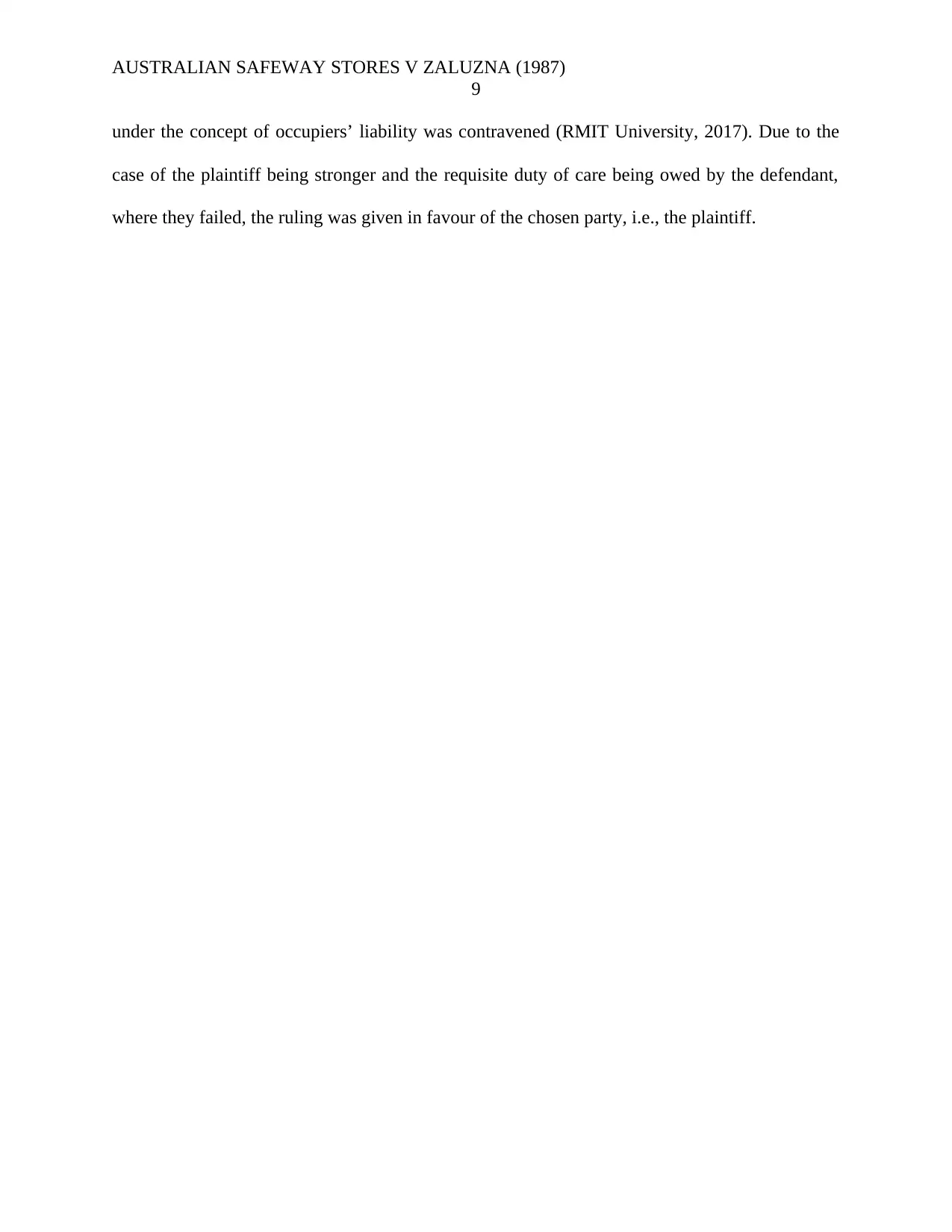
AUSTRALIAN SAFEWAY STORES V ZALUZNA (1987)
9
under the concept of occupiers’ liability was contravened (RMIT University, 2017). Due to the
case of the plaintiff being stronger and the requisite duty of care being owed by the defendant,
where they failed, the ruling was given in favour of the chosen party, i.e., the plaintiff.
9
under the concept of occupiers’ liability was contravened (RMIT University, 2017). Due to the
case of the plaintiff being stronger and the requisite duty of care being owed by the defendant,
where they failed, the ruling was given in favour of the chosen party, i.e., the plaintiff.
⊘ This is a preview!⊘
Do you want full access?
Subscribe today to unlock all pages.

Trusted by 1+ million students worldwide

AUSTRALIAN SAFEWAY STORES V ZALUZNA (1987)
10
References
Abbott, K., Pendlebury, N., and Wardman, K. (2007) Business Law. 8th ed. London: Thomson.
Australasian Legal Information Institute. (2017a) Australian Safeway Stores Pty Ltd v Zaluzna
[1987] HCA 7; (1987) 162 CLR 479 (10 March 1987). [Online] Australasian Legal Information
Institute. Available from:
http://www.austlii.edu.au/cgi-bin/sinodisp/au/cases/cth/HCA/1987/7.html?
stem=0&synonyms=0&query=zaluzna#disp11 [Accessed on: 03/09/17]
Australasian Legal Information Institute. (2017b) Australian Safeway Stores Pty Ltd v Zaluzna
[1987] HCA 7; (1987) 162 CLR 479 (10 March 1987). [Online] Australasian Legal Information
Institute. Available from:
http://www.austlii.edu.au/cgi-bin/viewdoc/au/cases/cth/HCA/1987/7.html [Accessed on:
03/09/17]
Harvey, B., and Marston, J. (2009) Cases and Commentary on Tort. 6th ed. New York: Oxford
University Press.
Jade. (2017) Australian Safeway Stores Pty. Ltd. v. Zaluzna. [Online] Jade. Available from:
https://jade.io/article/67406 [Accessed on: 03/09/17]
Latimer, P. (2012) Australian Business Law 2012. 31st ed. Sydney, NSW: CCH Australia
Limited.
Legal Helpdesk Lawyers. (2015) Australian Safeway Stores Pty Ltd v Zaluzna [1987] HCA 7| 10
March 1987. [Online] Legal Helpdesk Lawyers. Available from:
10
References
Abbott, K., Pendlebury, N., and Wardman, K. (2007) Business Law. 8th ed. London: Thomson.
Australasian Legal Information Institute. (2017a) Australian Safeway Stores Pty Ltd v Zaluzna
[1987] HCA 7; (1987) 162 CLR 479 (10 March 1987). [Online] Australasian Legal Information
Institute. Available from:
http://www.austlii.edu.au/cgi-bin/sinodisp/au/cases/cth/HCA/1987/7.html?
stem=0&synonyms=0&query=zaluzna#disp11 [Accessed on: 03/09/17]
Australasian Legal Information Institute. (2017b) Australian Safeway Stores Pty Ltd v Zaluzna
[1987] HCA 7; (1987) 162 CLR 479 (10 March 1987). [Online] Australasian Legal Information
Institute. Available from:
http://www.austlii.edu.au/cgi-bin/viewdoc/au/cases/cth/HCA/1987/7.html [Accessed on:
03/09/17]
Harvey, B., and Marston, J. (2009) Cases and Commentary on Tort. 6th ed. New York: Oxford
University Press.
Jade. (2017) Australian Safeway Stores Pty. Ltd. v. Zaluzna. [Online] Jade. Available from:
https://jade.io/article/67406 [Accessed on: 03/09/17]
Latimer, P. (2012) Australian Business Law 2012. 31st ed. Sydney, NSW: CCH Australia
Limited.
Legal Helpdesk Lawyers. (2015) Australian Safeway Stores Pty Ltd v Zaluzna [1987] HCA 7| 10
March 1987. [Online] Legal Helpdesk Lawyers. Available from:
Paraphrase This Document
Need a fresh take? Get an instant paraphrase of this document with our AI Paraphraser

AUSTRALIAN SAFEWAY STORES V ZALUZNA (1987)
11
https://legalhelpdesklawyers.com.au/2015/03/10/australian-safeway-stores-pty-ltd-v-zaluzna-
1987-hca-7-3-october-1987/ [Accessed on: 03/09/17]
Lunney, M., and Oliphant, K. (2013) Tort Law: Text and Materials. 5th ed. Oxford: Oxford
University Press.
O’Grady, P.T. (2015) Australian Safeway Stores Pty Ltd v Zaluzna [1987] HCA 7| 10 March
1987. [Online] Peter Thomas O’Grady. Available from:
https://peterogrady.com.au/2015/03/10/australian-safeway-stores-pty-ltd-v-zaluna-1987-hca-7-
10-march-1987/ [Accessed on: 03/09/17]
RMIT University. (2017) Negligence case study, Bert v GCS. [Online] RMIT University.
Available from: https://www.dlsweb.rmit.edu.au/lsu/content/D_BUS/law/negligence_LL/pdf/
negligence%20case%20study.pdf [Accessed on: 03/09/17]
Sappideen, C., at al. (2009) Torts, Commentary and Materials. 10th ed. Pyrmont: Lawbook Co.
Temby, I. (2015) Liability of occupiers of land for injuries sustained by people engaging in
recreational activities. [Online] Maddocks. Available from:
https://www.maddocks.com.au/liability-occupiers-land-injuries-sustained-people-engaging-
recreational-activities/ [Accessed on: 03/09/17]
11
https://legalhelpdesklawyers.com.au/2015/03/10/australian-safeway-stores-pty-ltd-v-zaluzna-
1987-hca-7-3-october-1987/ [Accessed on: 03/09/17]
Lunney, M., and Oliphant, K. (2013) Tort Law: Text and Materials. 5th ed. Oxford: Oxford
University Press.
O’Grady, P.T. (2015) Australian Safeway Stores Pty Ltd v Zaluzna [1987] HCA 7| 10 March
1987. [Online] Peter Thomas O’Grady. Available from:
https://peterogrady.com.au/2015/03/10/australian-safeway-stores-pty-ltd-v-zaluna-1987-hca-7-
10-march-1987/ [Accessed on: 03/09/17]
RMIT University. (2017) Negligence case study, Bert v GCS. [Online] RMIT University.
Available from: https://www.dlsweb.rmit.edu.au/lsu/content/D_BUS/law/negligence_LL/pdf/
negligence%20case%20study.pdf [Accessed on: 03/09/17]
Sappideen, C., at al. (2009) Torts, Commentary and Materials. 10th ed. Pyrmont: Lawbook Co.
Temby, I. (2015) Liability of occupiers of land for injuries sustained by people engaging in
recreational activities. [Online] Maddocks. Available from:
https://www.maddocks.com.au/liability-occupiers-land-injuries-sustained-people-engaging-
recreational-activities/ [Accessed on: 03/09/17]
1 out of 11
Related Documents
Your All-in-One AI-Powered Toolkit for Academic Success.
+13062052269
info@desklib.com
Available 24*7 on WhatsApp / Email
![[object Object]](/_next/static/media/star-bottom.7253800d.svg)
Unlock your academic potential
Copyright © 2020–2025 A2Z Services. All Rights Reserved. Developed and managed by ZUCOL.




